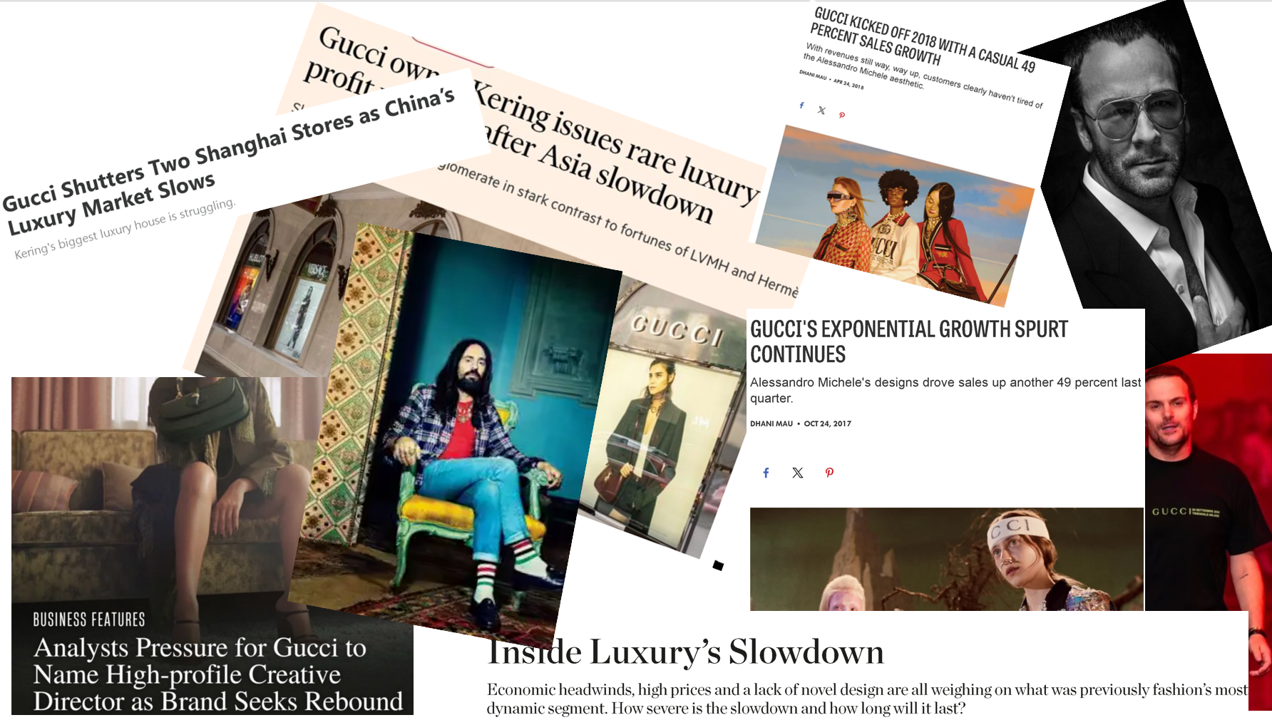The Fatigue of Brand Reinvention ?
The Limits of Logo Power: Gucci and the Risk of Brand Fatigue
In the luxury landscape, few questions are as pivotal—or as challenging—as this: How long can a brand sell the same style, anchored by a recognizable logo, before oversaturation erodes its allure? The answer: quite a while, but not indefinitely.
Amid a global slowdown in luxury spending, this question looms large. Recent market reports have cast a spotlight on Gucci, a titan of the industry now grappling with stagnation. Its position is particularly striking when compared to resilient outliers like Hermès, which continue to defy broader market contractions.
The Challenge of Reinvention in a Shifting Market
Historically, Gucci has been synonymous with reinvention. When faced with downturns, the brand has often responded with creative explosions that reshaped not just its own trajectory but the entire fashion landscape—Tom Ford’s provocative sensuality in the ‘90s, followed by Alessandro Michele’s whimsical maximalism that defined much of the last decade. Each pivot wasn’t just a refresh; it was a revolution.
But this time it feels different.
Unlike past downturns where Gucci’s revival coincided with broader industry stability, the current slowdown is industry wide. The global luxury market itself is showing signs of fatigue, with even dominant players seeing diminished growth trajectories. The question facing Gucci—and the luxury sector at large—is not just how to evolve, but whether previous formulas for success still hold in today’s shifting economic and cultural climate.
The Paradox of Exclusivity and Scale
At the heart of luxury lies an enduring paradox: brands must grow, but not too much. The essence of luxury is built on exclusivity, the idea that few can access what many desire. This delicate balancing act becomes increasingly precarious when a brand’s success leads to ubiquity.
Nowhere is this more evident than in the proliferation of Gucci’s iconic monogram. When once-coveted items like logo-emblazoned bags and sneakers become too common, they risk losing their aspirational edge. Unlike high-street fashion, where mass adoption signifies success, luxury thrives on scarcity. If too many people own the same product, the emotional value attached to exclusivity begins to erode.
A Case Study in Contrarian Creativity
Gucci’s recent history serves as a compelling case study in both audacity and risk. Before Michele took the creative reins in 2015, the brand was losing momentum, lagging behind competitors who were pivoting toward more understated expressions of luxury—what would later be termed quiet luxury.
Having witnessed this shift firsthand during my time in China, I observed the market’s clear move away from overt branding and toward discreet, logo-minimum designs that spoke of wealth through craftsmanship rather than conspicuous consumption.
Michele’s response? A complete reversal of the prevailing market mood. His exuberant, vintage-inspired aesthetic turned Gucci into the fashion disruptor of the moment. The result was staggering: within five years, Gucci’s revenue nearly tripled, as the brand captivated a global audience hungry for something bold, expressive, and unapologetically branded. Competitors who had once dismissed this maximalist revival were soon scrambling to replicate its success.
When Momentum Becomes Monotony
However, even the most disruptive aesthetics have a shelf life. Over time, Michele’s richly layered, eclectic vision began to feel repetitive. The sheer volume of products flooding the market—many featuring the now-ubiquitous Gucci monogram—led to inevitable brand fatigue. When a luxury product feels commonplace, its desirability begins to wane.
That said, it would be unfair to single out Gucci as the sole bearer of this burden. The broader market downturn suggests systemic challenges, not just creative stagnation.
Who Bears Responsibility for Brand Fatigue?
It’s also worth questioning whether a brand’s creative director should shoulder the entire weight of success—or failure. Luxury fashion houses are, after all, steered not just by visionary designers but also by CEOs, executives, and managing boards who dictate overall strategy.
When a brand begins to falter, it often seems convenient to position the creative lead as a scapegoat. Yet, long-term brand health relies on decisions made far beyond the design studio, including pricing strategies, market expansion, and how a brand balances growth with exclusivity.
What Comes Next for Gucci—and Luxury at Large?
The road ahead for Gucci—and indeed, the entire luxury sector—will require more than a creative shake-up. It will demand a rethink of what modern luxury means in a world where exclusivity is constantly threatened by scale.
As the industry searches for its next evolution, one thing remains clear: in luxury fashion, reinvention isn’t just an opportunity, it’s a necessity. However it must be tempered with maintaining brand equity.

